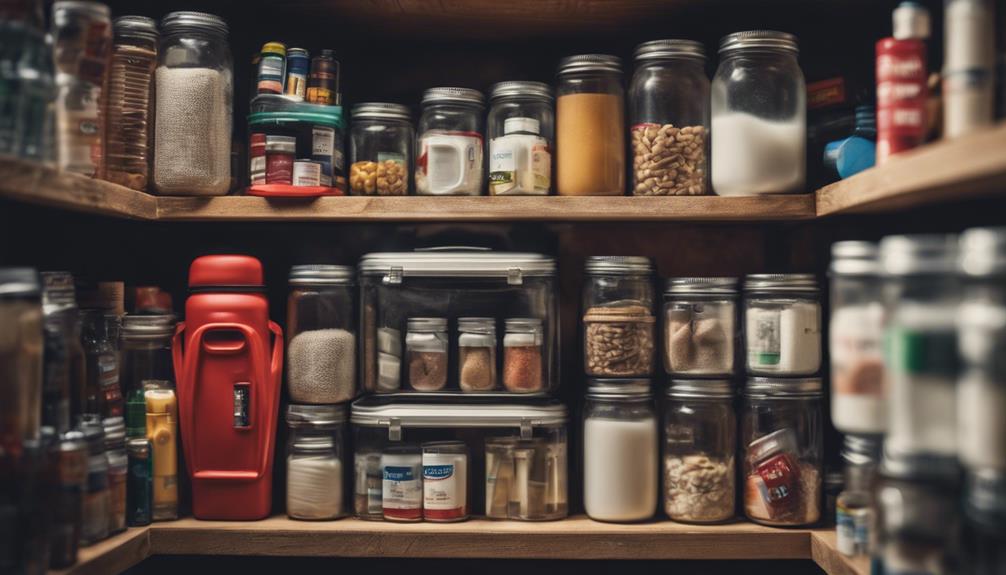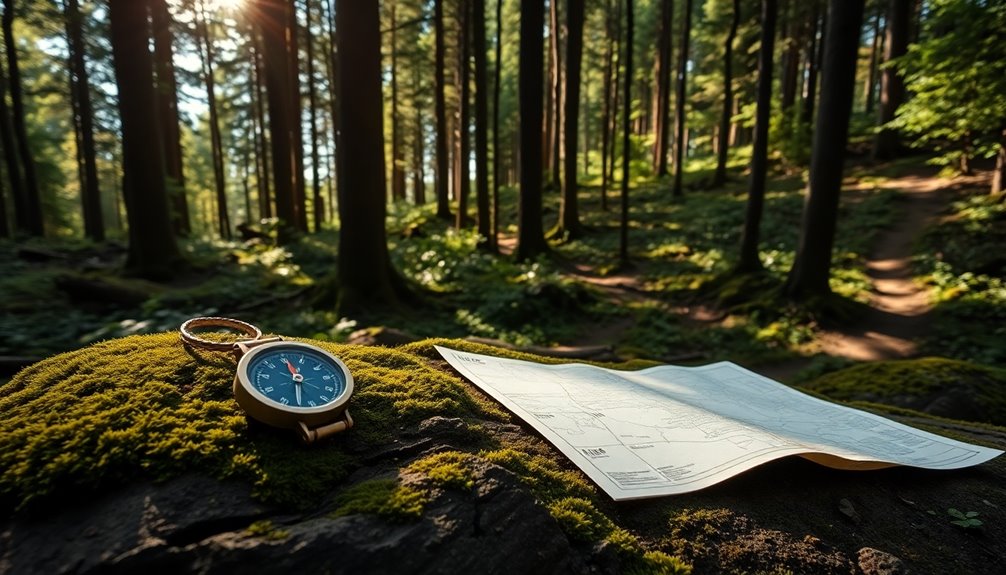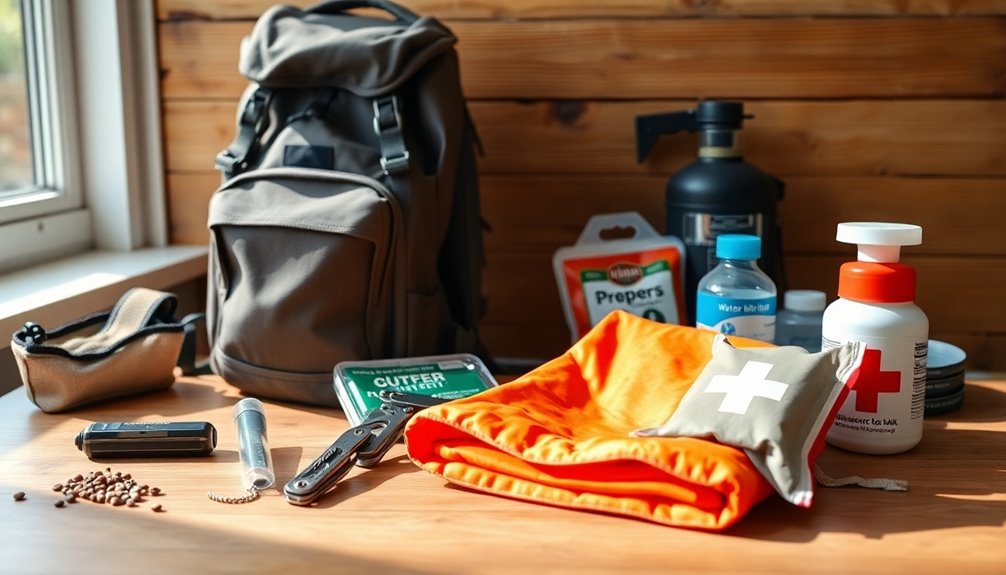You can master survival fishing using just a twig by crafting effective tools from simple materials found in nature. Start by shaping a sharp twig into a hook or spear, then use strong line materials like shoelaces or natural fibers. Employ techniques like direct hooking in shallow waters or gorge hooking in fast currents to catch fish. You can also set up camouflage traps to enhance your success. Understanding fish behavior and local species increases your chances even further. There's so much more to learn, including techniques and practices that can make you a true self-sufficient angler in challenging situations.
Key Takeaways
- Use sharp twigs to create hooks or spears for direct fishing in shallow waters or for spearfishing.
- Employ gorge hooking techniques, where sharp twigs lodge in the fish's throat, allowing for easier retrieval.
- Construct simple traps from twigs in high fish traffic areas for quiet and effective fishing.
- Blend your fishing setup with the environment to avoid detection, especially in spawning areas.
Overview of Survival Fishing
Survival fishing is an essential skill that allows you to catch fish with minimal equipment when food is scarce, ensuring you have access to important nutrition in emergencies. This skill emphasizes self-sufficiency, helping you stay prepared in challenging situations.
Understanding various techniques, like twig fishing or trap setting, enables you to adapt to different environments, whether it's a river, lake, or ocean. Knowledge of local fish species and their behavior plays a vital role in increasing your chances of success.
Essential Materials and Tools
To effectively catch fish in a survival situation, you'll need a few essential materials and tools at your disposal. These items will help you maximize your chances of success and guarantee you can sustain yourself.
- Twigs: Flexible branches for crafting hooks and spears.
- Line: Strong, improvised materials like shoelaces or natural fibers for fishing.
- Bait: Use worms, insects, or small fish to lure your catch.
- Hooks: Create hooks from metal scraps, sharp twigs, or wood to catch fish effectively.
Having these materials handy allows you to adapt to different fishing techniques and increases your chances of landing a meal in a survival scenario. Additionally, being well-prepared with a variety of tools ensures you can respond effectively to changing environmental conditions, such as weather or water currents. Incorporating items like fishing line, hooks, and multi-purpose knives into your wilderness survival gear essentials can make a crucial difference in securing food. This versatility not only boosts your confidence but can also be the key to sustaining yourself in unpredictable situations.
Twig Fishing Techniques

Using sharpened twigs as hooks allows you to effectively catch fish in various environments, making it a practical technique for your survival fishing efforts. Here's a quick guide on different twig fishing techniques you can use:
| Technique | Description | Best For |
|---|---|---|
| Direct Hooking | Use a sharp twig to hook fish directly. | Shallow waters and streams |
| Gorge Hooking | Create a twig with a sharp end to lodge in fish's throat. | Fast-moving waters |
| Floating Bait | Attach a baited twig to a floating line. | Lakes or calm waters |
| Camouflage Setup | Blend twigs with natural surroundings to avoid detection. | Spawning areas |
| Trap Construction | Build simple traps using twigs and foliage. | Areas with high fish traffic |
These techniques increase your chances of a successful catch.
Trapping and Spearfishing Methods
Trapping and spearfishing methods offer effective ways to secure food in challenging environments, enhancing your chances of survival. These techniques allow you to catch fish quickly and efficiently, even with minimal equipment.
Here are some methods you can try:
- Fish Traps: Construct a simple trap using twigs and natural materials to ensnare fish quietly.
- Spearfishing: Use a sharpened twig to create a spear, enabling you to target fish directly.
- Gorge Hooks: Craft hooks from sharp twigs that lodge in a fish's throat, making retrieval easier.
- Camouflage: Blend into your surroundings to avoid scaring fish away while you wait for your catch.
Mastering these techniques will increase your self-sufficiency in survival situations.
Environmental Awareness and Strategies

Understanding the environment around you boosts your chances of successful fishing while ensuring you use resources sustainably.
Pay attention to fish behavior, as they often feed more actively before storms and retreat afterward.
Look for natural features like eddies and deep pools; these spots serve as resting areas for fish.
At night, light can attract fish, so consider this when planning your fishing trips.
Keep your shadows off the water and minimize noise to avoid scaring them away.
By recognizing the patterns and habitats of local fish, you'll improve your success rate and contribute to the ecosystem's health.
Practicing these strategies not only enhances your skills but also fosters respect for the environment you rely on.
Safety and Legal Considerations
To guarantee a safe and responsible fishing experience, you must adhere to local regulations and practice sustainable techniques. Ignoring these can lead to legal issues and environmental harm.
Here are some essential safety and legal considerations:
- Check Local Laws: Always verify fishing permits, seasons, and size limits in your area.
- Practice Sustainability: Only catch what you need, and release any unwanted fish to maintain ecosystem health.
- Wear Safety Gear: Use gloves and protective clothing to prevent injuries from sharp objects or fish.
- Be Aware of Hazards: Stay alert for dangers like slippery rocks, strong currents, or wildlife that could pose risks while fishing.
Learning Resources and Practice

Building on the importance of safety and legal considerations, familiarizing yourself with effective learning resources and practicing your skills are key to mastering survival fishing.
Start by checking out survival fishing manuals and online tutorials for techniques and tips. Joining local fishing groups can provide valuable insights and opportunities for hands-on learning.
Don't hesitate to attend workshops where you can practice under expert guidance. Set aside time to practice in safe environments, experimenting with different methods like twig fishing or trap setting.
The more you practice, the more confident and skilled you'll become. Remember, the goal isn't just to catch fish but to develop resourcefulness and adaptability in any survival situation.
Frequently Asked Questions
What Is the Best Time of Day for Twig Fishing?
The best time for twig fishing is early morning or late evening. Fish are more active during these cooler hours, making it easier for you to catch them. Stay quiet and patient for the best results.
Can I Eat All Types of Fish Caught?
You might catch a beautiful trout, but not all fish are safe to eat. Some species can be toxic, so it's vital to identify what you're catching before you consider cooking and consuming it.
How Can I Identify Local Fish Species?
To identify local fish species, observe their habitats, colors, and behaviors. Research local guides or apps, or ask experienced anglers. Familiarizing yourself with common species helps you recognize them when you're fishing.
What Should I Do if I Catch a Fish With Parasites?
If you catch a fish with parasites, don't panic! Just clean it thoroughly, cooking it well to kill any unwelcome guests. Remember, it's better to be safe than sorry when it comes to your health!
How Do Weather Conditions Affect Fish Behavior?
Weather conditions greatly affect fish behavior. You'll notice they feed heavily before storms, seeking shelter afterward. Clear skies may prompt them to be more active, while overcast conditions can lead to increased feeding opportunities.
Conclusion
Mastering survival fishing with just a twig can be a game-changer in the wild.
Did you know that nearly 80% of the world's fisheries are overexploited or depleted?
That means honing your skills to catch fish sustainably is more essential than ever.
With the techniques you've learned, you can't only secure food for yourself but also appreciate the delicate balance of nature.
So, get out there, practice your skills, and embrace the adventure of survival fishing!










